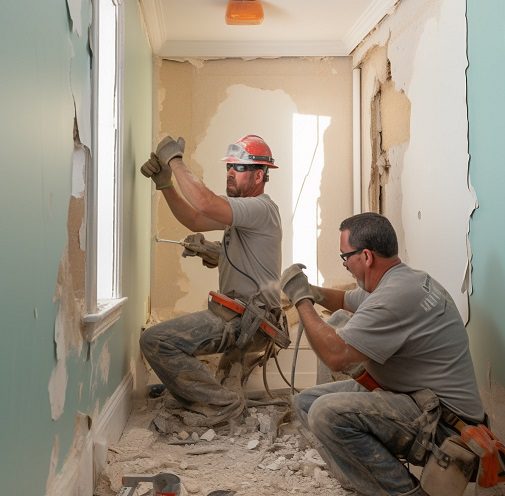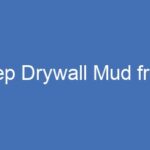Introduction
Drywall, a staple in modern construction, is the canvas of our home interiors. It’s essential not only for the aesthetics of our living spaces but also for their structural integrity. This article delves into the best practices for maintaining drywall surfaces, ensuring they remain pristine and durable over time.
Understanding Drywall Composition and Properties
Materials Used in Drywall
Drywall is primarily made from gypsum, a mineral known for its fire-resistant properties, sandwiched between two sheets of paper. It’s an efficient, cost-effective solution for creating smooth walls and ceilings.
Characteristics of Drywall
Its popularity stems from its ease of installation, soundproofing qualities, and versatility. Drywall comes in various types, including moisture-resistant and fire-resistant forms, catering to different needs in construction.
Preventative Measures for Drywall Longevity
To ensure the longevity of drywall, proper installation is key. It’s also vital to consider environmental factors like humidity and temperature, which can cause expansion and contraction. Preventative tips include:
- Using door stoppers to prevent knob holes.
- Keeping furniture at a distance to avoid scuffs and punctures.
Routine Maintenance and Cleaning
Maintaining the integrity and appearance of drywall surfaces is essential for the longevity of your home’s interior. Here’s a more detailed approach to routine maintenance and cleaning:
Dusting and Vacuuming
- Frequency: Dusting should be done monthly, while vacuuming with a brush attachment can be less frequent, depending on the dust accumulation in your home.
- Tools: Use a microfiber cloth to trap dust particles effectively or a vacuum cleaner with a soft brush attachment to gently remove dust without scratching the surface.
Stain Removal
- Immediate Action: Address stains as soon as they are noticed to prevent them from setting in.
- Cleaning Solution: Mix a small amount of mild detergent with water to create a cleaning solution.
- Application: Dip a soft cloth into the solution and wring it out to avoid excess moisture, which can damage the drywall.
- Technique: Gently dab and wipe the stained area. Do not scrub vigorously as this can damage the paper surface of the drywall.
Bi-Annual Maintenance Checks
- Visual Inspection: Look for any signs of damage, such as cracks, holes, or water stains.
- Environmental Check: Ensure that the room’s humidity levels are controlled to prevent the drywall from becoming too dry or too moist, which can lead to damage.
- Sealant and Paint: Check the integrity of the sealant and paint. Over time, these can deteriorate, requiring touch-ups or a new coat of paint to protect the drywall underneath.
Additional Tips
- Avoid Harsh Chemicals: Strong solvents can degrade the drywall’s finish and integrity.
- Touch-Ups: Keep some spare paint for minor touch-ups as needed to maintain a uniform appearance.
- Professional Advice: If you’re unsure about the type of cleaning agent to use or how to address a particular type of stain, consult with a professional before proceeding.
By adhering to these routine maintenance and cleaning practices, you can ensure that your drywall remains in pristine condition, contributing to the overall beauty and value of your home.
Identifying Common Drywall Problems
Cracks and Holes
Cracks and holes in drywall are common issues that can be caused by a variety of factors. Settlement of the building’s foundation, changes in temperature and humidity, or accidental impacts are all common causes of these problems. These issues often start small and can worsen over time, so regular inspections are crucial for catching them early.
By identifying cracks and holes early, homeowners can address them before they become larger and more difficult to repair. Prompt attention to these problems can help maintain the structural integrity and appearance of the walls.
Water Damage
Water damage is a serious issue for drywall and can have various causes, such as plumbing leaks, roof leaks, or flooding. Signs of water damage include staining, peeling paint, softening of the drywall, and a musty odor. It’s crucial to take immediate action upon discovering water damage to prevent further deterioration and the potential growth of mold and mildew.
If left untreated, water-damaged drywall can compromise the integrity of the entire structure and create an environment conducive to harmful mold growth. Properly addressing water damage is essential to protecting both the structural integrity of the building and the health of its occupants.
Mold and Mildew
Mold and mildew can thrive in damp and humid environments, making them common problems in areas affected by water damage. These microbial growths not only compromise the appearance of the walls but also pose significant health risks to the occupants of the building. Exposure to mold and mildew can trigger allergies, respiratory issues, and other health problems.
It’s important to address mold and mildew promptly using proper cleaning agents or, in the case of extensive growth, seeking professional help. Additionally, taking steps to control moisture levels and improve ventilation can help prevent future mold and mildew problems. Regular cleaning and maintenance can contribute to a healthier indoor environment and prolong the life of the drywall.
Scratches
Aside from cracks and holes, scratches are another common issue that can affect drywall. They can be caused by various factors such as accidental scrapes from furniture, rough handling during home renovations, or even pet activity. While scratches may seem minor compared to other drywall problems, they can detract from the overall appearance of the walls, especially if they accumulate over time.
Addressing scratches promptly with minor repairs can help maintain the aesthetic appeal of the walls and prevent them from becoming more pronounced. Additionally, taking preventive measures such as using furniture pads and careful handling during home maintenance activities can help minimize the occurrence of scratches on drywall surfaces.



Repairing Drywall Damage
Repairing Cracks and Holes
Repairing drywall damage from cracks and holes is a common home maintenance task that, when done properly, can restore the integrity and appearance of your walls. Here’s a detailed guide on how to effectively address these issues:
1. Clean and Prepare the Area
Begin by clearing the damaged area of any loose debris, dust, or paint chips. A clean surface ensures better adhesion for the repair materials.
2. Assess the Damage
Evaluate the size and nature of the cracks or holes. Small cracks may only require a superficial fix, while larger holes may necessitate more extensive repairs.
3. Crack Repair
For hairline cracks, use a flexible crack filler or joint compound. Apply the filler with a putty knife, smoothing it over the crack. Allow it to dry thoroughly.
4. Small Hole Repair
For small holes, such as those left by nails or screws, use spackle or joint compound. Fill the hole with the compound, level it with the surrounding surface, and let it dry.
5. Medium to Large Hole Repair
For larger holes, cut away any damaged or protruding edges to create a clean, geometric shape. Attach a piece of drywall or a pre-made patch to cover the hole, securing it with screws. Apply joint compound over the seams and edges of the patch, feathering it out to blend with the surrounding wall. Sand the area once the compound is dry.
6. Texture Matching
If your walls have a textured finish, attempt to match the texture when applying joint compound. You can use specialized texture tools or techniques to replicate common finishes like orange peel or knockdown.
7. Sand the Repaired Area
After the compound is completely dry, sand the repaired area using fine-grit sandpaper. Feather the edges to ensure a smooth transition between the repair and the existing wall.
8. Prime the Repaired Area
Apply a primer to the repaired area to enhance paint adhesion and create a uniform surface. Allow the primer to dry before proceeding to the next step.
9. Paint Matching
Select a paint color that matches the existing wall. Use leftover paint from the original painting job if available. Apply the paint to the repaired area, feathering the edges for a seamless finish.
10. Inspect and Repeat if Necessary
Inspect the repaired area after the paint has dried. If any imperfections are still visible, repeat the process by applying additional joint compound, sanding, priming, and painting until the repair is satisfactory.
11. Prevent Future Damage
Identify and address the underlying cause of the cracks or holes, such as settling, water damage, or structural issues.
Use anchors or wall plugs for heavy items to prevent unnecessary stress on the drywall.
12. Professional Assistance
For extensive damage or if you are uncertain about the repair process, consider consulting a professional drywall contractor.
By following these steps, you can effectively repair drywall damage from cracks and holes, restoring the structural integrity and visual appeal of your walls. Regular maintenance and prompt attention to any new damage will help keep your walls in optimal condition over time.
Repairing Damage Caused By Water
Repairing drywall damage caused by water damage involves a comprehensive process to restore the structural integrity and aesthetics of the affected area. Here’s a detailed guide on how to effectively address water-damaged drywall:
1. Assessment and Safety
Begin by assessing the extent of the water damage. Identify areas of saturation, swelling, or discoloration on the drywall.
Ensure safety by turning off electricity in the affected area to prevent electrical hazards.
2. Water Extraction and Drying
Remove any standing water using a wet/dry vacuum or a pump.
Set up fans and dehumidifiers to expedite the drying process. Adequate ventilation is crucial to prevent mold growth.
3. Remove Damaged Drywall
Cut out and remove any visibly damaged or saturated drywall. This may involve cutting along the edges of the affected area using a utility knife.
Ensure that the remaining drywall is completely dry before proceeding.
4. Inspect and Address Structural Damage
Examine the underlying structure for any signs of rot or deterioration. Replace or repair any compromised framing or insulation.
Treat the affected areas with mold inhibitors to prevent future mold growth.
5. Mold Prevention
Apply a mold-resistant primer to the exposed surfaces to inhibit the growth of mold and mildew.
Monitor the humidity levels in the room and address any potential sources of moisture.
6. Drywall Patching
Cut a new piece of drywall to fit the opening. Secure it in place with screws or nails.
Apply joint compound over the seams and joints, using mesh tape to reinforce the repair.
Sand the patched areas once they are dry, and apply additional coats of joint compound as needed until the surface is smooth.
7. Priming and Painting
Prime the repaired area to ensure even paint absorption and to create a uniform surface.
Paint the patched area to match the surrounding wall. This helps to seamlessly blend the repair with the existing wall.
8. Final Touches
Reinstall any fixtures, baseboards, or trim that were removed during the repair process.
Inspect the repaired area to ensure a seamless integration with the surrounding wall.
9. Preventative Measures
Identify and address the source of the water damage to prevent future incidents.
Consider installing water-resistant drywall or using moisture-resistant paint in areas prone to water exposure.
By following these steps, you can effectively repair drywall damage caused by water and prevent potential issues such as mold growth and structural compromise. Remember that if the water damage is extensive or if you’re unsure about the repairs, it’s advisable to consult with a professional contractor.
Repairing Damage Cause By Mold and Mildew
Addressing drywall damage caused by mold and mildew involves a meticulous process to eliminate the fungal growth, repair the affected areas, and implement preventative measures to discourage future mold issues. Here’s a comprehensive guide on how to effectively repair drywall damaged by mold and mildew:
1. Safety Precautions
Before starting any work, wear protective gear such as gloves, goggles, and a mask to safeguard yourself from mold spores.
Isolate the affected area to prevent the spread of mold during the remediation process.
2. Assessment and Identification
Thoroughly inspect the drywall to identify the extent of the mold damage. Look for discoloration, musty odors, or visible mold growth.
Determine the cause of the mold, such as leaks, poor ventilation, or high humidity.
3. Moisture Source Mitigation
Address and rectify the source of moisture to prevent mold from returning. Repair leaks, improve ventilation, and reduce humidity levels.
Consider using dehumidifiers in damp areas to maintain optimal humidity levels.
4. Mold Removal
Carefully remove any mold-infested drywall using a utility knife, making sure to cut beyond the visibly affected area to ensure complete removal.
Bag and dispose of the contaminated drywall properly.
Clean and disinfect the surrounding areas with a mold-killing solution, following manufacturer guidelines.
5. Structural Assessment
Inspect the underlying structure for any signs of mold growth or deterioration. Replace any compromised framing or insulation.
Apply a mold inhibitor to the exposed surfaces to prevent the recurrence of mold.
6. Drywall Replacement
Cut out and replace the removed drywall sections with new, mold-resistant drywall.
Seal joints and seams with mold-resistant joint compound and tape to ensure a seamless repair.
7. Ventilation Improvement
Enhance ventilation in the affected area by installing exhaust fans, ensuring proper air circulation, and allowing natural sunlight to reach the space.
8. Application of Mold-Resistant Products
Use mold-resistant primers and paints on the repaired drywall to create a protective barrier against future mold growth.
9. Regular Inspection and Maintenance
Periodically inspect the repaired area and adjacent spaces for any signs of moisture or mold.
Promptly address any water leaks or damage to prevent the recurrence of mold issues.
10. Educate and Encourage Good Practices
Educate occupants about the importance of proper ventilation, maintaining reasonable humidity levels, and promptly addressing water leaks.
Encourage the use of mold-resistant products in areas prone to moisture, such as bathrooms and basements.
By following these steps, you can effectively repair drywall damage caused by mold and mildew, mitigate the risk of future mold growth, and create a healthier indoor environment. If the mold infestation is extensive or if you are unsure about handling the remediation, it’s advisable to consult with a professional mold remediation specialist.
Repairing Damage Caused By Scratches
Addressing drywall damage caused by scratches involves a relatively straightforward yet detailed process to restore the surface to its original smoothness. Here’s a comprehensive guide on how to effectively repair drywall damage from scratches:
1. Clean the Area
Begin by cleaning the scratched area to remove any dust, dirt, or loose particles. A clean surface ensures better adhesion of repair materials.
2. Assess the Depth of the Scratch
Evaluate the depth of the scratch to determine the appropriate repair method. Superficial scratches may only require a surface-level fix, while deeper scratches may need more extensive attention.
3. Fill Surface Scratches
For minor surface scratches, use a lightweight spackle or joint compound to fill the damaged area. Apply the compound with a putty knife, spreading it evenly over the scratch. Allow it to dry according to the product instructions.
4. Sand the Repaired Area
Once the filler is dry, sand the repaired area with fine-grit sandpaper. Feather the edges of the repair to seamlessly blend it with the surrounding wall. This step ensures a smooth and even surface.
5. Prime the Repaired Area
Apply a primer to the sanded area to promote adhesion and create a consistent surface for paint application. Allow the primer to dry completely before proceeding.
6. Paint Matching
Choose a paint color that matches the existing wall color. If possible, use leftover paint from the original painting job to ensure a perfect match.
7. Paint the Repaired Area
Apply the chosen paint to the repaired area using a brush or roller. Feather the paint along the edges to blend it seamlessly with the surrounding wall. Allow the paint to dry completely.
8. Inspect and Repeat if Necessary
Inspect the repaired area once the paint is dry. If the scratch is still visible, repeat the process by applying an additional layer of spackle or joint compound, sanding, priming, and painting until the repair is satisfactory.
9. Consider Texture Matching
If the wall has a textured finish, match the texture when applying the spackle or joint compound. Various textures, such as orange peel or knockdown, can be replicated using specialized tools or techniques.
10. Prevent Future Scratches
Install corner guards or beading to protect vulnerable areas from future scratches.
Educate household members or occupants about proper handling and care to minimize the risk of accidental scratches.
11. Professional Assistance
For extensive or challenging drywall damage, or if you are uncomfortable with the repair process, consider consulting a professional painter or drywall contractor.
By following these steps, you can effectively repair drywall damage caused by scratches, restoring the wall to its original condition and maintaining the aesthetic appeal of your living space.
Professional Assistance
When in doubt, seeking professional help ensures the best outcome for complex repairs.
Painting and Finishing Drywall
Preparation
Before painting, ensure the surface is clean, dry, and smooth. Apply a primer to enhance paint adhesion.
Paint Selection
Opt for paints designed for drywall, considering sheen and color that best suit the room’s function and lighting.
Professional Finish
Achieving a professional look involves even application and attention to detail, especially at edges and corners.
Advanced Drywall Care
Upgrading insulation and soundproofing can enhance the comfort of your space. For tech-savvy homes, retrofitting for in-wall systems may require professional modification of the drywall.
Wrapping Up
Maintaining drywall surfaces is a critical aspect of home upkeep. With regular care and prompt attention to damage, drywall can maintain its integrity and appearance for years to come.
Yes, but you need to use the proper anchors or fasteners designed for drywall. It’s crucial to locate a stud if the object is particularly heavy.
It’s a good practice to inspect your drywall at least once a year for any signs of damage or wear. More frequent checks may be necessary if you live in an area with high humidity or drastic temperature changes.
Yes, wallpaper can be removed from drywall, but it must be done carefully to avoid damaging the surface. Use a scoring tool and wallpaper removal solution, and consider using a steamer for stubborn adhesives.
Certain pests, like termites and carpenter ants, can damage drywall. Be on the lookout for signs of infestation and address any pest problems promptly to prevent structural damage.
For soundproofing, use specially designed acoustic drywall, add a second layer of drywall with dampening glue, or install soundproofing insulation between the drywall and the studs.
FAQs
tag: # Maintaining Drywall Surfaces







